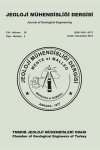
ABSTRACT: KM2 and KM3-lignite seams occur in the Kısrakdere coal zone of Miocene aged Soma formation. Thethickness of the KM2 coal seam varies between 1 and 25 meters above the contact with the underlying mudstonesat the base of the Neogene sequence in the Soma-Eynez coal field. This field is one of the major coal productionareas in Turkey. Underground coal production has been conducted in the KM2-coal seam located above theM2-marl unit with Miocene in age. Subsurface openings in Işıklar longwall-panels is located at 291 m depthfrom the ground-surface level created due to the underground coal mining. Limestone (M3) and marl (M2)layers deformed and formed a jointed structure due to the subsidence. Thus, these voids fractured and collapsedinto the openings, with resultant lowering of the ground surface on the run-off mine road. The boundary of thesurface area affected from the subsidence is defined by the angle of influence. Subsidence caused differentialsettlement, with the greatest amount on a fault zone which vertically cuts the longwall panels, not near thecenter of the opening. As a result, asymmetrical subsidence profile developed in the area. The extend and size ofground surface cracks are expected to increase until the subsidence is completed in the area. The developmentof ground-crack patterns on the run-away mine showed some differences along the subsidence profile. Differentcrack patterns were observed in the extraction and the gap zones (subsided zone) of this profile. These patternswere used in the constitution of subsidence profile in this work. Subsidence was investigated in the cross-sectionsconstructed by either vertical or parallel to the run-off mine road. Different break angles were determined onthese sections. The causes obtained different break angles are due to the preparation of the cross-sections bothparallel and vertical to the fault zone and the coal seam, and different topography. Because the cross-sectionconstructed in N-S direction has a topography with slope. The angle of influence (limit angle) about the coalproduction panels were investigated in two different cross-sections. In the cross-section with N-S direction, limitangles for both sides of the longwall panel were determined by using the finite element method. In the crosssection with E-W direction, limit angles were determined on the cross-section produced with the help of thedifferent subsidence crack patterns developed on the ground surface and the measurements of deformation onthe survey points along the run-off mine road. The results obtained from the two methods were correlated witheach other. It was determined that angular differences acquired from the two methods have a range changingbetween 7° and 10°.
ABSTRACT: This paper deals with the short description of Menard pressuremeter and the evaluation of Menardpressuremeter tests carried out in two boreholes drilled at Kuloğlu Hydroelectric Power Plant (HPP)regulator which is one of the HPP Projects planned at Aşağı Aras basin. 8 pressuremeter tests in SK-1borehole and 12 pressuremeter tests in SK-2 borehole were carried out at alluvium unit in the foundationsite. Menard pressuremeter tests could not be carried out due to the collapsing and enlarging of thedrillholes after 20 and 24 meter depths of boreholes. Two group of settlement and bearing capacity analysiswere performed with the assumption of alluvium made up of homogeneous and heterogeneous. Immediatesettlement computation and stress distribution analysis were also performed beside the pressuremeteranalysis. The amount of settlement and bearing capacity of the alluvium are in acceptable limits in thedepths of which the test could be applied. The stress from regulator load decreases to % 10 at a depth ofgreater than 48 m. Due to the collapsing-enlarging of the boreholes after 20 and 24 m depths and theload-related stress increase acting greater depths, the excavation of the all alluvial soils is suggested. Atthe end of this study, the problems arisen from application of Menard pressuremeter test for the hydraulicstructures are outlined.
ABSTRACT: Izmir is the third biggest metropolitan city in Turkey with a population more than 4 million. Thequarries which presently supply aggregate to the ready-mixed concrete plants and cement factories inand around the metropolitan city of İzmir are expected to be closed down in the near future due to theircloseness to the settlement areas and the environmental problems they create. Thus it is necessary tofind new crushed rock areas that will meet the future aggregate needs of the city. It is envisaged that theaggregate needs of the city will be met partially from the Mesozoic aged limestones of the KaraburunPeninsula. In this study, the facies and chemical properties of Mesozoic aged limestones of the KaraburunPeninsula have been investigated and the influences of these properties on the usability as concreteaggregate were evaluated. The results indicated that the most important property affecting the usage ofthe limestones as concrete aggregate is found to be silica content. It affects the purity of the limestonesby causing alkali silica reaction in concrete. Additionally, it has been noted that the clay containingaggregates in the limestones are found to decrease the strength of the concrete.
ABSTRACT: Plants accumulates a lot of elements and determination of the amount of elements in the plantsis important for biogeochemical prospecting. 14 plant species and 220 plant and soils samples werecollected from Kırka (Eskişehir) primarily, Bigadiç (Balıkesir) and Emet (Kütahya) boron deposits areaand element contents of plant and soil samples were determined. The biogeochemical anomalies were determined with the help of the statistical relations between element contents of the soil and the plantspecies samples. There are no statical relationship established between the Zn, Cu, Ni ve Co values of plantand soil samples. Twigs of Gypsophila perfoliata L. (n=13, r=0.79, R²=0.62, P<0.01 for Mn) observedwere found to be indicator plants. The indicator plants could be successfully used for biogeochemicalprospecting and environmental monitoring. In addition, the correlation analysis was performed in orderto determine the inter-elemental relationships between the soil (for B, Sr, Li, Mn, Zn, Cu, Ni and Co) andMn in G. perfoliata L. While there is a positive significant (S) relationship between Mn in plant and Mn insoil, there is a negative significant(-S) relationship between Mn in plant and Li in soil.

 TMMOB
TMMOB